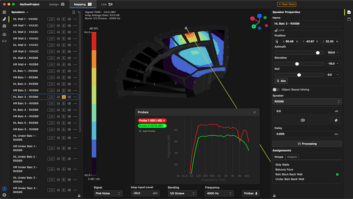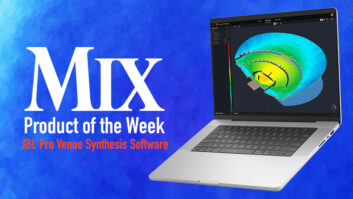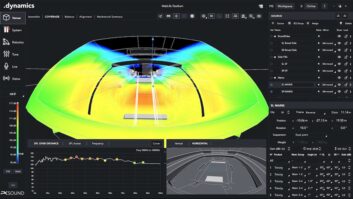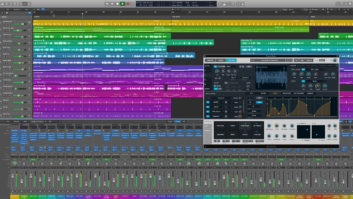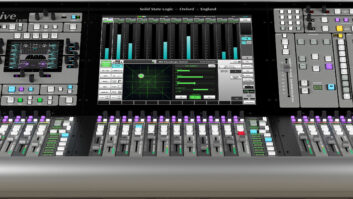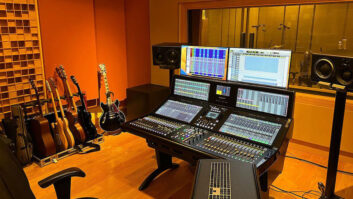As we turn over the calendar to another New Year, we in the audioindustry find ourselves asking the age-old question: Will we still havea job 12 months from now?
Actually, most of us don’t usually ask ourselves thatquestion, which is what makes this year so strange. But because we areliving in the greatest era of uncertainty in about six decades, no onecan really forecast what’s going to happen. Let’s try to hang on to apositive thought: Even hunkered down in bacteria-proof undergroundshelters, people are going to need to be entertained, and they will be,even if it means using car batteries to run their brand-new surroundDVD systems.
So this month, let’s not look at the gloomy side. With the WinterNAMM show right around the corner, let’s instead ask ourselves thatupbeat question that will be on the lips of everyone gathering inAnaheim: Is hardware dead?
Well, maybe that’s not terribly upbeat for a lot of people— like the folks who make hardware — but it certainly seemsto be getting a lot of attention. There are legions of people, themajority of them under 25, who think that using hardware forsynthesizing, recording, processing and mixing music is so, well, so’90s. They’ve never known a time when computers weren’t fast andreliable enough to produce and manipulate untold numbers of tracks ofsuper-high-fidelity audio in real time. They’re looking at us oldfogies and our racks of processing gear, and wondering why we need allthat iron when they can do everything they can even conceive of on a$700 motherboard with a $200 sound card.
The other day, one of my students was describing his home studio tome, and when I asked him what kind of synths he had, he replied,“Oh, I don’t have anything like that. It’s all software. And Idon’t play the piano very well, so I never bothered to get a keyboard.Hardware’s dead, anyway.” A friend of mine, who also teachescollege-level music courses, gave a lecture recently to a gathering ofthe local audio community on “Better Living Through SoftwareSynthesis.” “It’s viable, it works,” he says.“Do we need a box to do DSP or a special chip to do synthesis?Why bother?” Why indeed?
As much as in any field, computers have become “anything andeverything machines” in the audio world. Do you want to dolocation recording? Get a laptop and a PCM interface card, and put itin a corner of that road case with your mics, preamps and headphones.Do you do film scoring or sound effects? Install a software sampler ortwo and a virtual rack of soft synths and plug-ins on your desktopmachine, link them to timecode and mix it all down right to your harddisk; when you’re done, burn it onto a CD-ROM and send it to the Avidhouse. Is your specialty dance records or club mixes? All you need is abunch of CDs of grooves and beats, looping software and a vocal mic.How about processing, sweetening, mixing and mastering other artists’recordings? All possible without ever turning away from yourmonitor.
In many ways, a software-based studio makes a lot of economic sense.After all, could you throw out an entire hardware studio that’s onlytwo years old and replace it with the next generation of faster,slicker gear — and end up spending only $1,000? If everything’sin software, that’s not only easy, it’s more or less mandatory. (Ofcourse, the disadvantage is that you then have to reinstall all yoursoftware and spend a few sleepless nights fretting over whether or notyour old programs will work on the new platform. Can you imagine havingto do all that with a couple of racks full of hardware?)
But somehow, there are people out there who aren’t getting themessage — like the ones who send me those glossy 150-plus-pagemusic and pro audio catalogs every month. Despite my student’spronouncement, lots of areas of the hardware business are still goingquite strong, thank you very much.
Roland’s disk-based, all-in-one studios have been that company’smost successful new product line in years, and now the other usualsuspects — Fostex, Yamaha, Tascam and Alesis — have jumpedon board. Despite the flood of software synths, the “knobs”craze on hardware synthesizers shows no sign of abating, as musiciansrediscover the joys of real-time control and learn that there arebetter ways to design sounds than tweaking parameters on a crowded LCD,or even on a 20-inch monitor.
DJ gear, of course, is going like gangbusters: CD players thatemulate vinyl turntables, groove boxes that emulate the crummy drummachines of the early ’80s, and nasty high-Q filters you can operate bywaving your hands around in the air are flying out dealers’ doors. It’san interesting indicator of how the hardware world is evolving byconsidering that Alesis, which owned the project studio multitrack tapedeck market for the better part of a decade, last year somehow managedto go bankrupt and had to be rescued by Numark, a company that has madeits money in the club scene over many years.
Guitars, basses and amps are still big moneymakers, and the marketfor vintage and pseudovintage axes is as healthy as ever. There are somany different variations on Strats, Teles, Les Pauls, 335s and TwinReverbs that the mind boggles. (Although I still can’t imagine that a$1,500 guitar with some rock god’s signature on it actually plays twiceas nicely as the $750 version from the same manufacturer.) On the otherhand, the sounds of the guitars are becoming less distinguishable fromeach other, as more manufacturers pick up on the “modeling”idea, so that any combination of guitar and amp can sound like anyother combination you want. (I have my doubts about this technology,though, especially for live performance. I was at a demo/concert of onemanufacturer’s electronic instruments recently, and the guitarist,trying to emulate a stack of Marshalls with a little stage amp, soundedas if he was miles away in a completely different hall from the rest ofthe band. Maybe it was the mix, or maybe it was a latency problem, butit wasn’t in the least convincing.)
For those of us who want to use all of our fingers and otherappendages to work with sound, hardware is still rather necessary. Whatall of the devices I just listed have in common is that they offerfamiliar physical interfaces: knobs, faders, strings, frets, turntablesand so on. As we all have discovered during the past few years, movinga mouse around is a lousy way to create music, or edit or mix audio.And so we’ve seen the rise of “control surfaces” that hookup to our computer-based workstations through serial or USB connectorsand emulate the mixing and editing consoles we are used to.
It’s not just a gimmick that these devices present a familiar face.Despite our generally positive attitude toward new technologies,musicians and audio professionals tend to be a fairly entrenched lot,and old habits die hard. We learn to use certain types of systems— in the case of musicians, we spend years practicing them— and develop our working style and rhythm on them, and we aren’tthat interested in abandoning them overnight, even if there are newways that are immediately and obviously superior. While we embrace newtechnology, we want it to work like the old, and manufacturers that tryto force us out of old habits are taking a risk.
Examples of this are all over the place. In the film world, thewidespread use of digital media at the dubbing stage took an amazinglylong time to happen, even though the magnetic-dubbing technology theycould replace should have been put out to pasture years before. Itwasn’t until digital dubbers were designed to closely emulate magneticones — to become their “analogues,” as it were— that they were able to gain acceptance.
There’s a similar situation in radio: Endless-loop cartridgemachines, one of the worst-sounding and most finicky technologies I’veever had the displeasure of working with (I spent a year cleaning andaligning the suckers, so I know!), are still in use in many places— you can often hear the “ka-chunk” of the cart deckwhen the announcer forgets to mute his mic — despite the factthat digital audio systems and servers can do the job much better, notto mention that they don’t need cleaning. Many digital systems, infact, emulate the old cart machines and have front panel slots forremovable disks, even though with today’s high-capacity hard disks andhigh-speed interconnects, they are hardly necessary.
But the role of hardware is not nearly the same as it has beentraditionally. Perhaps the major change that computers have wrought, interms of how hardware is used in the audio world, can be described as akind of paradigm shift: Form no longer needs to follow function. Thanksto the explosion of computing power in cheap, mass-produced chips andmotherboards, and the almost total removal of analog electronics fromthe signal path, what a device looks like no longer needs todepend on what it does. Barriers between different functions— this box here is supposed to do one thing, while that box theredoes something else — are no longer necessary, or even desirable.Compressors and equalizers don’t have to be in racks.Synthesizers don’t have to have keyboards. Dubbers don’thave to use tape. And guitars don’t have to sound likethemselves.
Instead, the physical form of a tool can be anything we want it tobe. A tool’s form may be defined as a result of its function — ahard disk recorder can still look like a tape deck — or itmay be completely independent. Alesis’ new airFX and airSynth look liketrackballs from the helm of the Starship Enterprise, but you don’ttouch them — they change their synthesis and DSP parameters basedon the relative x, y and z coordinates of your hand. It’s a far cryfrom knobs and keys. Yamaha’s WX wind controllers resemble mutantsoprano saxophones, but not only can you make any kind of sound youlike with them, you can also play them polyphonically — whichheretofore only Roland Kirk could do (and he needed two instruments).With new touch-sensitive fabrics such as those developed by Tactex,which are able to generate data in three dimensions, any kind ofsurface can be turned into any kind of controller.
Familiar tools can also be “extended” — given newtasks to do that are similar to their traditional tasks, but with awider sonic or functional palette. One of the most interesting newconcepts I’ve heard about involves, believe it or not, turntables. It’sa kind of double-reverse: The turntables aren’t doing what turntablesnormally do (in the post-analog era, that is), i.e., play records inweird ways. Instead, they are acting as controllers for a digitalsystem that, well, plays records in weird ways.
You might have read about it in last month’s Remix magazine: A couple of clever DJs havefigured out a way to have access to hundreds of records without havingto carry around heavy crates of vinyl. They show up with only two vinyldiscs and a laptop. The discs have nothing but SMPTE timecode recordedon them. They feed the output of the turntables through a converterinto the computer, which is loaded up with audio files (.WAV or MP3)and some custom software. They tell the software which files they wantto play, and start spinning the platters. The timecode on eachturntable tells the computer where to start playing each file, how fastand in which direction. The DJs can skip around, go faster and slower,and backward and forward, just as if they were playing vinyl records— but when they want to change records, instead of having to swapvinyl discs, they simply call up a new file on the computer.
Right now, the system, which is being produced in limited numbers,has a pretty steep price tag: around $3,000. But by the time you readthis, Stanton, a turntable and cartridge manufacturer, will have aproduction version that promises to cost a lot less. After that, whoknows — maybe someone will come out with a “virtual”turntable and laser-equipped tone arm that doesn’t need any records atall. And then they can put some touch sensors in them so that if youbang on them, they make a sound like a stylus skipping…
As the functions of our tools and the forms they take continue todisengage from each other, we can expect to see some radical newdesigns in human/machine interfaces. Some of these will be brilliant,some will be awful, and some no doubt will be both. With any luck, thepresent trend in software front end design, in which every programresembles either the console of a spaceship or a nightmarish oozingprimordial Salvador Dali landscape, will abate, and new designaesthetics that are more inspiring and less self-conscious willprevail.
But however technology develops, it’s a safe bet that reports of thedeath of hardware will continue to be, as Mark Twain might have put it,premature. As long as we have hands, fingers and feet, we will need tobe able to hold, push, turn, press, squeeze and stomp on our tools ifthey are going to feel like they’re ours. Until, of course, purelysynaptic-driven interfaces (with appropriate neural feedback) areperfected. At that point, all bets are off.
“Insider Audio” columnist and Mix Web editorPaul D. Lehrman knows that next year’s model will be different. Justdon’t ask him how.


